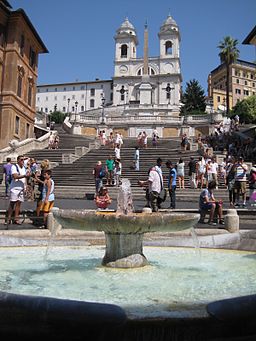Spanish steps
| Spanish Steps | |
| Scalinata di Trinità dei Monti (Italian) | |
| Stairway | |
|
The Spanish Steps, seen from Piazza di Spagna. In foreground, the Fontana della Barcaccia
|
|
| Location | Rome, Italy |
|---|---|
| - coordinates | 41°54′21.7″N 12°28′58.0″E / 41.906028°N 12.482778°ECoordinates: 41°54′21.7″N 12°28′58.0″E / 41.906028°N 12.482778°E |
| Designer | Francesco de Sanctis |
| Construction | 1723–1725 |
| - Opened | 1725 |
| Steps | 135 |
The Spanish Steps (Italian: Scalinata di Trinità dei Monti) are a set of steps in Rome, Italy, climbing a steep slope between the Piazza di Spagna at the base and Piazza Trinità dei Monti, dominated by the Trinità dei Monti church at the top.
The monumental stairway of 135 steps (the slightly elevated drainage system is often mistaken for the first step) was built with French diplomat Étienne Gueffier’s bequeathed funds of 20,000 scudi, in 1723–1725, linking the Bourbon Spanish Embassy, and the Trinità dei Monti church that was under the patronage of the Bourbon kings of France, both located above — to the Holy See in Palazzo Monaldeschi located below. The stairway was designed by architects Francesco de Sanctis and Alessandro Specchi.
Following a competition in 1717 the steps were designed by the little-known Francesco de Sanctis, though Alessandro Specchi was long thought to have produced the winning entry. Generations of heated discussion over how the steep slope to the church on a shoulder of the Pincio should be urbanised preceded the final execution. Archival drawings from the 1580s show that Pope Gregory XIII was interested in constructing a stair to the recently completed façade of the French church. Gaspar van Wittel's view of the wooded slope in 1683, before the Scalinata was built, is conserved in the Galleria Nazionale, Rome. The Roman-educated Cardinal Mazarin took a personal interest in the project that had been stipulated in Gueffier's will and entrusted it to his agent in Rome, whose plan included an equestrian monument of Louis XIV, an ambitious intrusion that created a furore in papal Rome. Mazarin died in 1661, the pope in 1667, and Gueffier's will was successfully contested by a nephew who claimed half; so the project lay dormant until Pope Clement XI Albani renewed interest in it. The Bourbon fleur-de-lys and Innocent XIII's eagle and crown are carefully balanced in the sculptural details. The solution is a gigantic inflation of some conventions of terraced garden stairs. The Spanish Steps, which Joseph de Lalande and Charles de Brosses noted were already in poor condition, have been restored several times, most recently in 1995. A new renovation commenced on May 30, 2016 and the steps reopened on September 21, 2016.
...
Wikipedia


